Order of Cultural Merit 문화훈장 (文化勳章)

When the Korean War broke out on Jun. 25, 1950, Korea had only two Orders. They were the Grand Order of Mugunghwa 무궁화대훈장 (無窮花大勳章) which went to the president of the country and the Order of National Foundation 건국공로훈장 (建國功勞勳章) which was awarded to those who had fought against the Japanese occupation of Korea. With the war in full swing, it was necessary for Korea to establish an Order of Military Merit. But, in addition to the thousands of soldiers entering the country, there were thousands of other foreigners coming to Korea’s aid. It quickly became apparent that another Order was needed for the civilians. The Order of Cultural Merit was created to award both Korean and foreign personnel in recognition of their outstanding meritorious contributions in the fields of diplomatic service, military affairs, social relief, development of national economy, and other services rendered in the interest of the improvement of national welfare and productivity. In time, as new Orders were created, the areas covered by this award were reduced.
1951 SERIES
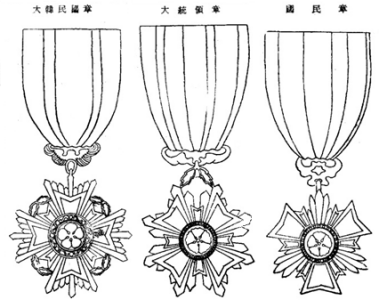
Official Gazette 관보 (Kwan Bo)
The original Order of Cultural Merit was established on Dec. 22, 1951 by Presidential Decree #582, in three classes. All three classes are mounted on 40 × 47 mm breast ribbons. There are no weights given in the legislation. The ribbon bars are slightly narrower at 36 × 11 mm. The original 1951 legislation lists the dimensions for the color/stripes on the ribbon, but it did not list the colors in order. There have been several observed medals where the ribbons were fresh and yet, the stripe patterns were reversed from each other.
- Republic of Korea Medal 대한민국장 (大韓民國章). The major diameter of the pendant is 50 mm. The ribbon color/stripe pattern is orange (9 mm), yellow (5 mm), blue (12 mm), yellow (5 mm) and orange (9 mm). The ribbon bar is slightly narrower, so the blue stripe is 8 mm instead of the 12 mm found on the breast ribbon. The sun rays in small, medium and large sizes symbolize the historical development of cultural exchange with foreign countries; the Mugunghwa in the center of the medal and leaves around the medal, national prosperity; the golden chain, cultural diplomacy with foreign countries; and the wings of a dove, peace; The orange, yellow, and blue colors of the ribbon indicate the ideal development of civilization.
- Presidential Medal 대통령장 (大統領章). The major diameter of the pendant is 46 mm. The color/stripe pattern is: blue (6 mm), red (3 mm), white (7 mm), yellow (7 mm), white (4 mm), red (9 mm) and blue (4 mm). On the ribbon bar, the color/stripe pattern is the same, but with the yellow reduced from 7 mm to 3 mm. The symbolism of the Presidential Medal is similar to the 1st Class. The chain circle symbolizes cultural continuity from antiquity through present and future times. The Mugunghwa, its leaves and wings of a dove, are the same as the seal of the state.
- National Medal 국민장 (國民章). The major diameter of the pendant is 42 mm. The color/stripe pattern is: red (6 mm), blue (10 mm), white (10 mm), red (5 mm), yellow (7 mm) and red (1 mm). On the ribbon bar, the white stripe is reduced from 10 mm to 7 mm. The general design and symbolism are similar to the 2nd Class, except that there are only three rays. The bat shaped chain symbolizes the process of cultural cultivation.
1957 SERIES
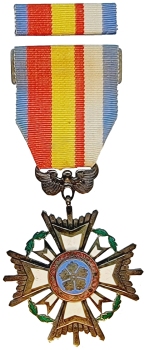
Examples have been observed with reversed ribbon stripe pattern
On July 31, 1957, the Korean government issued Presidential Decree #1299 for the Order of Cultural Merit. According to that legislation, there were no physical changes to the pendants, but there were changes to the ribbon. In 1958, the Korean government published a small book entitled: Award System of the Republic of Korea 상훈제도 대한민국.1 In the Korean and English text areas of the book, it clearly discusses the symbolism of the orange, yellow and blue stripes found on the 1951 Series 1st Class ribbon, but the pictures clearly show that there have been changes to the ribbons on all three classes. The book’s stripe/color pattern for the Order of Cultural Merit agrees with two observed specimens (a 1st Class and a 3rd Class), but not with all observed specimens.
- Republic of Korea Medal 대한민국장 (大韓民國章). The color pattern is: blue (5 mm), white (7 mm), red (3 mm), yellow (8 mm), red (9 mm) and blue (4 mm). As stated above, Here are two examples of this medal with the ribbon colors reversed. There was no fading to the ribbon.2
- Presidential Medal 대통령장 (大統領章). The book shows the color pattern as being: white (3 mm), red (9 mm), blue (3 mm), yellow (7 mm), white (7 mm), red (3 mm) and blue (5 mm). 3
- National Medal 국민장 (國民章). The book shows the color pattern as being: red (2 mm), blue (7 mm), white (4 mm), red (3 mm), yellow (7 mm), blue (9 mm) and red (4 mm). As stated above, an example of this medal has been observed, but with the ribbon colors reversed. There was no fading to that ribbon.4
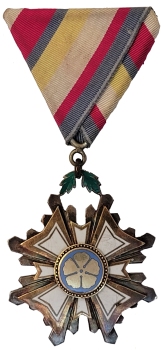
1963 SERIES
A new Order of Cultural Merit Decree #985 was issued on Sept. 29, 1962. With the Dec. 14, 1963 revisions in the Award System, the basis on which an Order of Cultural Merit was awarded became more restricted. Some of the earlier fields that qualified for this Order were given over to the newly created Orders of Service Merit, Diplomatic Service Merit and Industrial Service Merit. Hereafter, it was awarded to those who render meritorious service in the field of culture and distinguish themselves with the development and promotion of national welfare or culture. The appearance of the 1963 series is unique. The 1st class was composed of a pendant suspended from a bow. The 2nd class has the pendant suspended from a triangular shaped or trifold ribbon. The 3rd class was a standard breast badge. The physical dimensions for the pendants have not changed from the standards of the 1951 series.
- Republic of Korea Medal 대한민국장 (大韓民國章). The ribbon was a 120 × 36 mm bow. The ribbon color/stripe pattern is: blue (5 mm), white (7 mm), red (3 mm), yellow (9 mm), red (9 mm) and blue (3 mm).
- Presidential Medal 대통령장 (大統領章). The ribbon has been changed to a 32 × 36 mm trifold ribbon. (This is the only trifold ribbon ever used for a Korean Order.) The ribbon colors are: white (3 mm), red (9 mm), blue (3 mm), yellow (6 mm), white (6 mm), red (3 mm) and blue (6 mm).
- National Medal 국민장 (國民章). There is no change from the 1958 Series. The ribbon colors are: red (2 mm), blue (7 mm), white (4 mm), red (3 mm), yellow (7 mm), blue (9 mm) and red (4 mm)
1967 SERIES
A 1967 series for the Order of Cultural Merit 문화훈장 (文化勳章) does not exist. On Jan. 16, 1967 under Decorations Law #1885, it officially became a part of the Order of Civil Merit 국민훈장 (國民勳章). The names of the various classes of the previous Cultural Merit Series were transferred to the Order of National Foundation. Each of the old Classes was transferred directly into the Order of Civil Merit. (If someone lost their 2nd Class Order of Cultural Merit and wanted a replacement, they would receive a 2nd Class Order of Civil Merit).
1973 SERIES
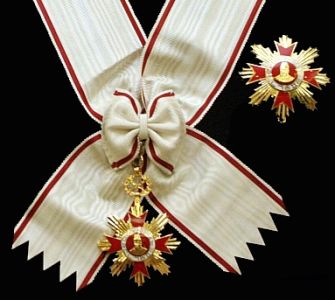
The Order of Cultural Merit 문화훈장 was re-established in five classes, on Jan. 25, 1973 under Decorations Law #2447. But, the physical appearance of the Order of Cultural Merit wasn’t finalized until Nov. 1, 1973 under Presidential Decree #6916. With the creation of several new Orders, the Order of Cultural Merit became a sort of Lifetime Achievement Award for the Arts. The 1973 Series follows the European usage of sashes, breast stars, etc., except for the 5th class, which has a rosette on the ribbon. In addition, each class has a 38 × 10 mm ribbon bar and 12 × 8 mm lapel pin. Both the ribbon bar and lapel pin have stripe patterns which strongly mimic the ribbon. The likeness of King Sejong is found on the lapel pins, but not on the ribbon bars.
- Geum-gwan Medal 금관장 (金冠章) Gold crown. The pendant has a major diameter of 60 mm, a minor diameter of 50 mm and weighs 42.7 grams. The sash is 80 × 1700 mm in size, and has two stripes, one on each side. The stripe/color pattern is: white (2 mm) (백), red (5 mm)(적), white (66 mm), red (5 mm) and white (2 mm). The breast star has a major diameter of 70 mm, a minor diameter of 57 mm and weighs 50.7 grams. The stripe pattern on the ribbon bar is: white (1 mm), red (6 mm), white (24 mm), red (6 mm) and white (1 mm).
- Geum-gwan 금관장 (金冠章) – Sized for Women 숙녀용. The pendant, breast star, ribbon bar and lapel pin are identical to the men’s size. The only difference is the sash, which is 65 × 1700 mm. The stripe/color pattern is: white (2 mm)(백), red (5 mm)(적), white (51 mm), red (5 mm) and white (2 mm).
- Eun-gwan Medal 은관장 (銀冠章) Silver crown. The pendant has a major diameter of 55 mm, a minor diameter of 46 mm, and weighs 37.4 grams. The cravat is 38 × 600 mm in size, and has eight red (적) 1.5 mm stripes, four on each side of a 3.5 mm white (백) center stripe. The breast star has a major diameter of 60 mm, a minor diameter of 50 mm and weighs 42.7 grams. The ribbon bar has the same stripe/color pattern as the cravat.
- Bo-gwan Medal 보관장 (寶冠章) Precious crown. The pendant has a major diameter of 50 mm, a minor diameter of 41 mm, and weighs 26.7 grams. The cravat is 38 × 600 mm in size, and has six 1.5 mm red (적) stripes, three on each side of a 17 mm white (백) center stripe. There is no breast star. The ribbon bar has the same stripe/color pattern as the cravat.
- Og-gwan Medal 옥관장 (玉冠章) Jeweled crown. The pendant has the same major diameter (50 mm), minor diameter (41 mm), and weight (26.7 g.), the same size as the third class. It is mounted on a 38 × 100 breast ribbon and has four 1.5 mm red (적) stripes, two on each side of a 24 mm white (백) center stripe. There is a rosette on the ribbon. The ribbon bar has the same stripe/color pattern as the breast ribbon.
- Hwa-gwan Medal 화관장 (花冠章) Flower crown. The pendant has the same major diameter (50 mm), minor diameter (41 mm), and weight (26.7 g.), the same size as the third and fourth classes. It is mounted on a 38 × 100 breast ribbon and has two 2 mm red (적) stripes, one on each side of a 30 mm center stripe. There is a rosette on the ribbon. The ribbon bar has the same stripe/color pattern as the breast ribbon.
Symbols employed: The writing brush found on the suspension device indicates writing, while the laurel crown, which is also found on the suspension, means peace and freedom. The red wings refer to the brilliance of the hard work. The sun’s rays symbolize the heightened dignity of the country. The red on the center plate means passion and patriotism. The Korean character around the center plate suggests the superiority of Hangul, the Korean alphabet. The likeness of King Sejong reminds us of the great works of the King, which includes the invention of the Korean alphabet. The white color of the ribbon refers to the purity of the nation, (white is the traditional color of Korean clothes), while the red color on the wings indicates patriotism and love of the people.
1974 SERIES
In 1974, the government issued a new Decorations Law Enforcement Decree. There were no changes to the Order of Cultural Merit.5
1984 SERIES
Decorations Law Enforcement Decree #11336 was enacted on Jan. 23, 1984. Like the earlier series, the 1984 Series follows the European usage of sashes, breast stars, etc., except for the 5th class, which has a rosette on the ribbon. In addition, each class has a 38 × 10 mm ribbon bar and a 12 × 8 mm lapel pin. Both the ribbon bar and lapel pin have striped/color patterns which strongly mimic the ribbon. The likeness of King Sejong is found in the center of the pendants, breast stars and on the lapel pins, but not on the ribbon bars. The pendant for the third, fourth and fifth classes are nearly identical to the pendant used for the Women’s first class award. The differences in weight are due to the inclusion of the ribbon’s weight.
- Geum-gwan Medal 금관장 (金冠章) Gold Crown. The pendant has a major diameter of 70 mm, a minor diameter of 57 mm, and weighs 70 grams. The sash is 80 × 1800 mm in size, and has two stripes, one on each side. The stripe/color pattern is: white (2 mm) (백), red (5 mm) (적), white (66 mm), red (5 mm) and white (2 mm). The breast star has a major diameter of 80 mm, a minor diameter of 65.1 mm and weighs 85 grams. The ribbon bar has a stripe/color pattern which is: white (1 mm), red (6 mm), white (24 mm), red (6 mm) and white (1 mm). The stripes on the lapel pin are 1.5 mm wide, one each side of a 4 mm white center stripe.
- Geum-gwan Medal 금관장 (金冠章) Gold Crown, (sized) for Ladies. The pendant has a major diameter of 50 mm, a minor diameter of 40.7 mm, and weighs 38 grams. The sash is 65 × 1,700 mm in size, and has two red (적) stripes, one on each side of the center stripe. The stripe/color pattern is: white (2 mm) (백), red (5 mm) (적), white (51 mm), red (5 mm) and white (2 mm). The breast star has a major diameter of 55 mm, a minor diameter of 44.8 mm and weighs 43 grams. The ribbon bar has a stripe/color pattern which is: white (1 mm), red (6 mm), white (24 mm), red (6 mm) and white (1 mm). The stripes on the lapel pin are 1.5 mm wide, one each side of a 4 mm white center stripe.
- Eun-gwan Medal 은관장 (銀冠章) Silver Crown. The pendant has a major diameter of 60 mm, a minor diameter of 48.9 mm and weighs 50 grams. The cravat is 38 × 600 mm in size, and has eight 1.5 mm red (적) stripes, four on each side of a 13 mm white (백) center stripe. The breast star has a major diameter of 70 mm, a minor diameter of 57 mm and weighs 66.5 grams. The dimensions of the stripes on the ribbon bar are the same as the cravat. The red stripes on the lapel pin are .2 mm wide on either side of a white 4 mm center stripe.
- Bo-gwan Medal 보관장 (寶冠章) Precious Crown. The pendant has a major diameter of 50 mm, a minor diameter of 40.7 mm, and weighs 35.5 grams. The cravat is 38 × 600 mm in size, and has six 1.5 mm red (적) stripes, three on each side of the 19 mm white (백) stripe. There is no breast star. The stripes on the ribbon bar are the same as the cravat. The six red stripes on the lapel pin are .2 mm wide, with three on either side of a white 5 mm center stripe.
- Og-gwan Medal 옥관장 (玉冠章) Jeweled Crown. The pendant has the same major diameter (50 mm) and minor diameter (40.7 mm), the same dimensions as the third class, however, according to the legislation, the weight is 34 g. The pendant is mounted on a 38 × 100 mm breast ribbon and has four 1.5 mm red (적) stripes, two on each side of a 24 mm white (백) center stripe. There is a rosette on the ribbon. The ribbon bar has the same stripe/color pattern as the breast ribbon. The red stripes on the lapel pin are .3 mm wide, with two on each of a white 5 mm white center stripe.
- Hwa-gwan Medal 화관장 (花冠章) Flower Crown. The pendant has the same major diameter (50 mm), minor diameter (40.7 mm) and weight (34 g.), the same as the fourth class. It is mounted on a 38 × 100 breast ribbon and has two 2 mm red (적) stripes, one on each side of a 30 mm white (백) center stripe. There is a rosette on the ribbon. The ribbon bar has the same stripe/color pattern as the breast ribbon. The red stripes on the lapel pin are .5 mm wide, with one on each side of a white 5 mm center stripe.
CURRENTLY
Since 1984, the Decorations Law Enforcement Decree has been changed 19 times. The current legislation is Decree #30517 and was enacted on March 10, 2020. In the intervening years, the only major change was to the Geum-gwan Medal 금관장 (金冠章) Gold Crown, (sized) for Ladies. It was found to be discriminatory and was dropped in 2016.6 The only other change was that the current legislation uses the word 흰색 for white, instead of the original term 백색. The same is true for the color red. The current legislation uses the term 붉은색 instead of 적색. All other dimensions, weights, etc. remain the same.
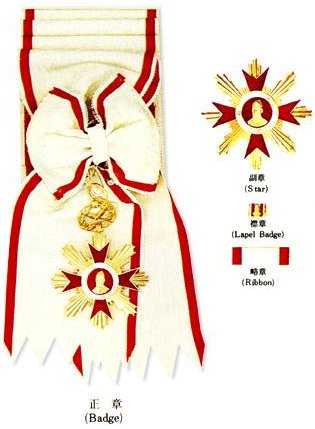
관장 (金冠章)
Gold Crown
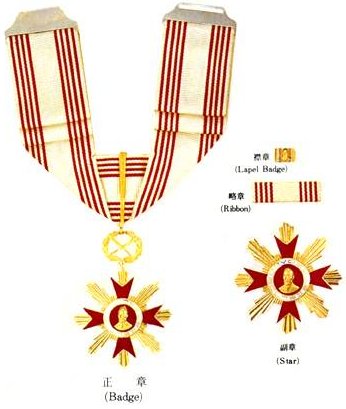
은관장 (銀冠章)
Silver Crown
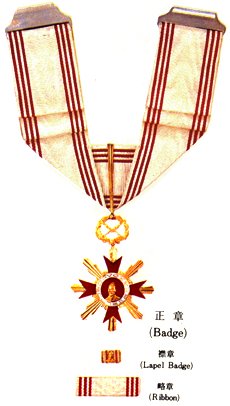
보관장 (寶冠章)
Precious Crown
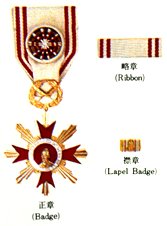
옥관장 (玉冠章)
Jeweled Crown
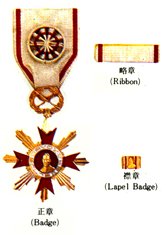
화관장 (花冠章)
Flower Crown
Additional Information: Not only are Cultural Artists eligible for the Order of Culture, but the supporters of artistic venues are also eligible under Presidential Decree #12351, The Act on Revitalization of Support for Culture and Arts, (Jan. 28, 2014), Article 11.
Footnotes:
- The book is not dated, but the publication date can be approximated. The book shows the changes that were made to the Order of National Foundation, which were enacted by Presidential Decree #1346 in 1958.
- The dimensions listed were taken from observed specimens.
- The dimensions listed were estimated from available pictures.
- The dimensions listed were taken from observed specimens.
- 상훈법시행령 [일부개정 1974.10.23 대통령령 제7289호]
- Decorations Law Enforcement Decree 상훈법 시행령, Presidential Decree #26838 대통령령 제26838호, dated 2015.12.31 and implemented on 2016.1.1.[시행 2016.1.1.], partial revision 일부개정.
